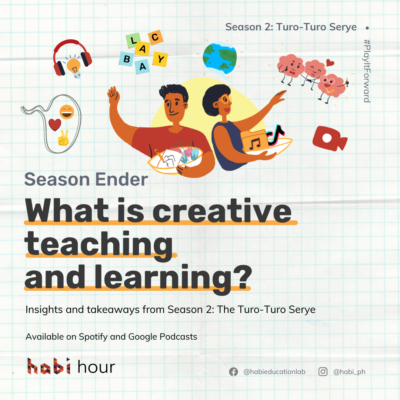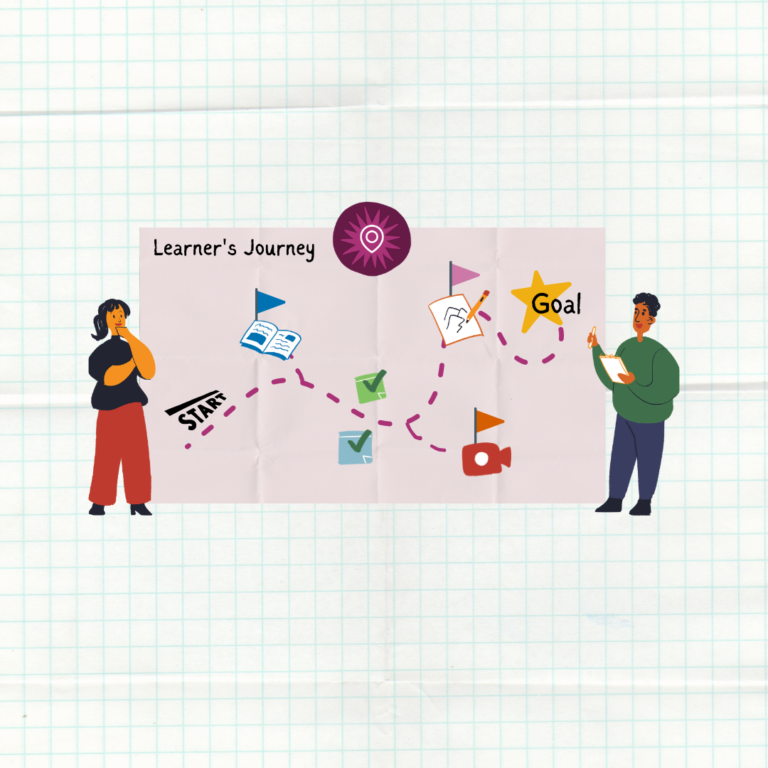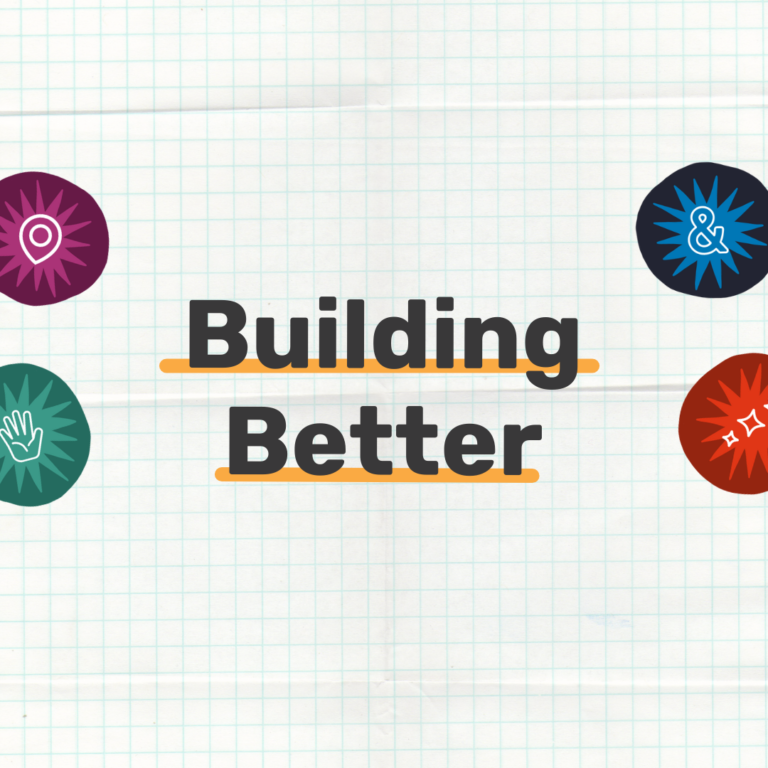Insights and takeaways from Season 2: The Turo-Turo Serye
Overview
23 July 2021 | 12 min and 8s
4 months and 14 episodes in, we ask ourselves this sticky question – What is creative teaching and learning?
For Habi Hour’s Season 2 finale, let’s listen to what we’ve learned about creative teaching and learning, some key takeaways, and what it means for us as learning experience designers. #LXDTayo
Transcript
Introductions
VOICE OVER: Sa ikalawang season ng Habi Hour, hinimay natin ang lawak at lalim ng kung ano ang creative teaching and learning. Ito ang naging paksa ng ating Turo-Turo Serye – isang buong season kung saan tayo nagkuwentuhan tungkol sa Creative Teaching and Learning.
We had conversations on using specific strategies such as check-ins, Roses Thorns and Buds, Feedback, and Productive Play. We had stories on using TikTok, music and Education Technology to enrich learning experiences.. We also shared stories about how having creative support groups, both structured tulad ng mga LACs natin, or unstructured, barkada natin, and how they can create empowering learning environments which impact creativity.
We learned about strength-based approaches through the lens of neurodiversity, and in the last 2 episodes, we invited learners to celebrate their strengths and the strengths of their teachers during this remote learning situation. Whew! Ang dami na rin pala talaga nating napagkuwentuhan, ‘no?
14 episodes in – how do we make sense of creative teaching and learning? I’m Celina at samahan ninyo ako as we close this season with some familiar friends from Habi and our Manghahabi Community.
[Habi Hour Intro]
On putting learners at the center
CELINA: Creative teaching and learning, we’ve found, involves a lot of putting learners at the center.
GERSON: Creative teaching will not look the same across different contexts because, precisely, it is created in that moment, in that interaction between the teacher, the student, the environment, and the materials that they have.
So imagine, para siyang, you know, when musicians improvise, or when performers cater their performance to a particular audience who is there at that moment. It’s very ethereal. It’s very at that moment, created between those two people as an interaction.
JOAN: Because you understand who your learners are, what their needs are, how they learn, why they need to learn whatever the subject is. It gives you that ability to design the processes based on the learners’ context.
GERSON: It’s when a teacher suddenly goes off script and adjusts the lessons because they realized something, or they sensed something from their students. It’s when a group of students suddenly went deeper into a project, into an inquiry, just because they thought it was very relevant, even though it wasn’t asked from them by their teachers.
JOAN: Because learning experiences that are engaging is ownership to the outcomes. Often, higher engagement leads to deeper learning. It needs to be able to activate different brain spaces as learners learn differently. We need to use different approaches to see what works well.
On adapting and creating despite limitations and challenges
CELINA: Aside from adapting to and understanding the context of our learners, we are surrounded by many different things that can affect creative teaching and learning. We’ve learned that creative teaching and learning is context specific.
CHESS: After an entire season of listening to different stories on what creative teaching and learning is, for me, yung sagot ko sa tanong na ‘to, hindi ko siya matanggal sa context ng pandemya because it’s our current reality.
CELINA: Our challenge now is to rise above the tide and effectively adapt our ways of creative teaching and learning in our ever-changing contexts.
GERSON: The idea of creativity despite limitations, or creativity to address a problem, creativity to go beyond the scope of what we have.
GEN: Having limitations, whether it’s your materials, or your platforms
GERSON: I think about the limitations in technology, the limitations in curriculum, the limitations in materials, in access, in prior knowledge, in content knowledge.
GEN: Forces us to think outside of the box to overcome challenges
CELINA: It’s more than making do with what we have; it’s making the most of what we have and creating something better. Despite the limitations and challenges…
GERSON: The teacher and the learner are still able to co-create a learning experience – something magical, something substantial and relevant, and transformative.
CHESS: As we face this global pandemic, this is our call to action so that we can create not just a new normal, but a better normal for everyone.
On being rooted in purpose
CELINA: But it’s not solely about bringing in something new, or something big. It’s also about staying true to our purpose. Why do we teach what we teach? What is our goal? What is teaching and learning for?
JPAUL: At the end of the day, creativity is a tool or strategy in designing learning experiences for our students. It is also a tool we can use to learn more effectively. Hindi lang tayo magiging creative just for the heck of it, o kasi yun ang sinabi ng iba na dapat nating gawin. Pero dahil naniniwala tayong magagamit natin ang ating pagkamalikhain para tulungan ang ating mga mag-aaral, ang ating mga katrabaho, at ang ating mga sarili.
CELINA: Being rooted in purpose leads us to create something new AND worthwhile. And when your purpose is clear to you, it’s easier to confidently try out different ways of doing.
It’s when you don’t seek permission nor wait for a go signal because your intention or purpose is clear to you. It’s trusting that your creative game plan will work, either to solve a problem, or to teach where you might do better next time.
On deeper learning and building connections
RONEL: Creative teaching and learning happens when the teacher thinks of out-of-the-box ideas and the learners create their own learning.
GERSON: Imagine a class undergoing a lesson and they use their materials in a different way, or they use their physical environment and digital tools in a different way.
LANA: Creative teaching and learning is really about asking and reflecting on deeper questions. It’s about helping our students connect with themselves, connect with others, connect with the world, connect with the information that they’ve gotten, the mindsets that they are shifting, and the values that they are embodying.
GERSON: Creative solutions or creative ideas is when a group of people are able to overcome a certain challenge and build something new, create something new.
LANA: It’s about applying it, embodying it, deepening our practice and integration, so that we can have new processes, new ways of being, and new ways for looking at things.
On having a beginner’s mindset
CELINA: Narinig niyo na ba yung “Why fix something that’s not broken?” To that I’d say, even when your lesson has been working for the past 5, 10, 20 years you’ve been teaching the same thing, “Why not try something new and surprise yourself?”
And when your creative ideas do not always work – Sige lang nang sige. Prototype. Mahalaga rin ito sa creative teaching and learning. And here’s why:
BERNICE: Para sakin, teaching and learning creatively has an awareness that we won’t get it right that very first time. It might be wonderful, but there will always be ways to improve, and when we have that awareness, or actually, drive to improve, that’s where the creativity comes in in terms of learning and teaching.
MITZI: I think openness and being able to fail productively are essential mindsets that would help achieve it.
BERNICE: I think there needs to be this openness to make mistakes, openness to failure and seeing that some could be happy accidents
RONEL: Sabi nga dito sa Habi, sige lang nang sige.
CELINA: Looking back, the most creative teachers and students I’ve had are those who knew what strengths and talents they bring to the table, but still approach teaching and learning with a beginner’s mindset. Those who can say “I’m still learning” or “I don’t get it yet” or “I don’t have it all figured out” even with the wealth of knowledge and experience they actually already have. The most creative people I know are those who stay teachable. Creative teachers and learners think like beginners.
Synthesis and call-to-action
CELINA: There’s no single definition for what creative teaching and learning is. But this season, we learned that creativity in teaching and learning can be 1) putting your learners at the center, 2) adapting to changing contexts, 3) creating something better or trying something new while 4) staying rooted in your purpose. And finally, it’s staying teachable, open to different ideas and strategies no matter how great you already are.
Tulad sa isang turo-turo, maraming putahe, maraming pagpipilian, maraming puwede i-mix-and-match para sa isang nakakabusog at masayang experience. Napakaraming naibahaging kuwento ng mga kapwa-LXD, kapwa-guro, at pati ng mga estudyante natin. Aling mga putahe ang na-enjoy ninyo? Alin ang swak sa panlasa ninyo?
4 months and 14 episodes after, we are still in remote learning, and there are more challenges to come. Pabaon ng turo-turo namin ang paalalang ito: Hold out your plate. May mga nakasanayan ba tayong panlasang kailangan na munang i-let go? May mga putahe ba tayong hinahanap-hanap na parang naiba na ang timpla ngayon habang nagbabago ang mundo? As you hold out your plate, we hope you leave space everyday – to adapt to your learners’ contexts, to challenge your own beliefs and ways of doing, and to surprise yourself on what you can still do no matter where you are in your teaching and learning journey.
This has been Season 2, The Turo-Turo Serye: Creative teaching and learning tips for learning experience designers. Nabusog kami at sana nabusog din kayo. At kahit last episode na to for the season, mananatiling bukas ang Turo-Turong ito para sa inyo para balik-balikan at, sana sa susunod, mas marami pa tayong mga kaibigan na makasalo.
Hanggang sa muli!
[Habi Hour Outro]



